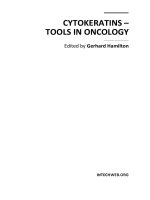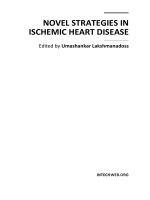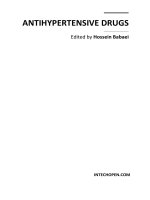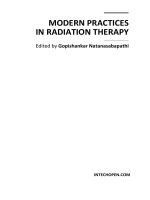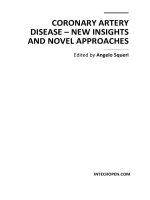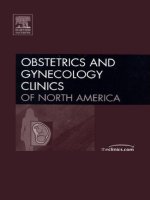Advances in Embryo Transfer Edited by Bin Wu pdf
Bạn đang xem bản rút gọn của tài liệu. Xem và tải ngay bản đầy đủ của tài liệu tại đây (4.09 MB, 260 trang )
ADVANCESIN
EMBRYOTRANSFER
EditedbyBinWu
Advances in Embryo Transfer
Edited by Bin Wu
Published by InTech
Janeza Trdine 9, 51000 Rijeka, Croatia
Copyright © 2012 InTech
All chapters are Open Access distributed under the Creative Commons Attribution 3.0
license, which allows users to download, copy and build upon published articles even for
commercial purposes, as long as the author and publisher are properly credited, which
ensures maximum dissemination and a wider impact of our publications. After this work
has been published by InTech, authors have the right to republish it, in whole or part, in
any publication of which they are the author, and to make other personal use of the
work. Any republication, referencing or personal use of the work must explicitly identify
the original source.
As for readers, this license allows users to download, copy and build upon published
chapters even for commercial purposes, as long as the author and publisher are properly
credited, which ensures maximum dissemination and a wider impact of our publications.
Notice
Statements and opinions expressed in the chapters are these of the individual contributors
and not necessarily those of the editors or publisher. No responsibility is accepted for the
accuracy of information contained in the published chapters. The publisher assumes no
responsibility for any damage or injury to persons or property arising out of the use of any
materials, instructions, methods or ideas contained in the book.
Publishing Process Manager Iva Simcic
Technical Editor Teodora Smiljanic
Cover Designer InTech Design Team
First published March, 2012
Printed in Croatia
A free online edition of this book is available at www.intechopen.com
Additional hard copies can be obtained from
Advances in Embryo Transfer, Edited by Bin Wu
p. cm.
ISBN 978-953-51-0318-9
Contents
Preface VII
Part 1 Introductory Chapter 1
Chapter 1 Advances in Embryo Transfer 3
Bin Wu
Part 2 Optimal Stimulation for Ovaries 19
Chapter 2 Minimal and Natural Stimulations for IVF 21
Jerome H. Check
Chapter 3 Does the Number of Retrieved Oocytes Influence Pregnancy
Rate After Day 3 and Day 5 Embryo Transfer? 39
Veljko Vlaisavljević, Jure Knez and Borut Kovačič
Chapter 4 Prevention and Treatment of Ovarian
Hyperstimulation Syndrome 53
Ivan Grbavac, Dejan Ljiljak and Krunoslav Kuna
Part 3 Advances in Insemination Technology 63
Chapter 5 Sperm Cell in ART 65
Dejan Ljiljak, Tamara Tramišak Milaković,
Neda Smiljan Severinski, Krunoslav Kuna
and Anđelka Radojčić Badovinac
Chapter 6 Meiotic Chromosome Abnormalities and Spermatic
FISH in Infertile Patients with Normal Karyotype 73
Simón Marina, Susana Egozcue, David Marina,
Ruth Alcolea and Fernando Marina
Chapter 7 New Advances in Intracytoplasmic
Sperm Injection (ICSI) 99
Lodovico Parmegiani, Graciela Estela Cognigni
and Marco Filicori
VI Contents
Chapter 8 Advances in Fertility Options of Azoospermic Men 115
Bin Wu, Timothy J. Gelety and Juanzi Shi
Part 4 Embryo Transfer Technology 133
Chapter 9 Increasing Pregnancy by Improving
Embryo Transfer Techniques 135
Tahereh Madani and Nadia Jahangiri
Chapter 10 Optimizing Embryo Transfer Outcomes: Determinants for
Improved Outcomes Using the Oocyte Donation Model 149
Alan M. Martinez and Steven R. Lindheim
Chapter 11 Importance of Blastocyst Morphology
in Selection for Transfer 161
Borut Kovačič and Veljko Vlaisavljević
Chapter 12 Pregnancy Rates Following Transfer of Cultured Versus
Non Cultured Frozen Thawed Human Embryos 177
Bharat Joshi, Manish Banker, Pravin Patel,
Preeti Shah and Deven Patel
Chapter 13 Intercourse and ART Success Rates 185
Abbas Aflatoonian, Sedigheh Ghandi and Nasim Tabibnejad
Part 5 Embryo Implantation and Cryopreservation 191
Chapter 14 Implantation of the Human Embryo 193
Russell A. Foulk
Chapter 15 Biomarkers Related to Endometrial
Receptivity and Implantation 207
Mark P. Trolice
1
and George Amyradakis
Chapter 16 Fertility Cryopreservation 225
Francesca Ciani, Natascia Cocchia,
Luigi Esposito and Luigi Avallone
Preface
Embryo transfer technology has become one of the prominent high businesses
worldwide in human and animal reproduction. As human in vitro fertilization (IVF)
technique rapidlydevelopsininfertilitytreatment,notonlyanimalIVFhasoffereda
veryvaluabletooltostudymammalianfertilizationandearlyembryodevelopmentas
treatment, but
also its commercial applications have being increased quickly. So far,
this technologyhasgonethrough threemajorchanges, thatis,(1)traditionalembryo
transfer(invivoembryoproductionbydonorsuperovulation)inanimals,especiallyin
cow,(2)invitroembryoproductionbyovumpickupwithinvitrofertilization(OPU‐
IVF)in humanand animalsand(3)notablycurrentcloningtechnique bysomatic cell
nuclear transfer and transgenic animal production. Embryo transfer technology has
widelybeenusedinanimalindustrytoimproveanimalbreeds. Inhuman,manyIVF
cliniccentershavebeensetupforinfertilitycoupletreatmentoverthewhole
world.
As embryo transfer techniques have accumulated over long period, many kinds of
books about embryo transfer on human and various animals have been published.
Most of books have described embryo transfer procedures and manipulation
protocols. The purpose of this book doesnotconcentrate on thedetaildescription of
basic embryo
transfer techniques and procedures, while we will update and review
some new developed theories and technologies and focus on discussing some
encountered problems during embryo transfer and give some examples how to
improve pregnancy rate by innovated techniques so that readers, especially
embryologists and physicians for human IVF programs, may
acquire some new and
usableinformationaswellassomekeypracticetechniques.
Thisbookcontainsfourpartswith16chapters.Firstly,anoptimalstimulationscheme
for ovaries, particularly natural and minimal stimulation of ovaries, has been
discussed in the first part. Then, one paper analyzed that how many oocytes per
retrieval willbe thebestforhumanIVFpractice.Ifonestimulation schemeproduces
too many eggs, it often results in hyperstimulation syndrome. Thus, a chapter
reviewed hyperstimulation syndrome diagnosis, prevention and treatment. In the
second part, some advanced technologies in insemination have been listed. After
introduction of normal sperm
physiology, sperm meiotic chromosome abnormalities
and DNA fragmentation infertile patients are analyzed. Then, newly developed
intracytoplasmic sperm injection (ICSI) techniques, such as intracytoplasmic
X Preface
morphologically‐selected sperm injection (IMSI) and selection of hyaluronan bound
spermforuseinICSI(PICSI), have beenreviewed.Finally, weintroducedsomenew
techniquesandmethodswhichcanmakeazoospermicmenrealizetheirdreamtohave
children. In the third part, it will mainly discuss how to increase pregnancy rate
by
improving embryo transfer procedures including optimal embryo transfer skills,
blastocystselectionandsingleembryotransfer,andtherelationshipofintercourseand
pregnancy success rate. In the last part, endometrial receptivity and embryo
implantationarediscussed,interestingly,morethan20biomarkershavebeenfoundin
uterus to determine embryo implantation
window and pregnancy failure. Thus, this
bookwillgreatlyaddsomenewinformationforembryologistsandIVFphysiciansto
improvehumanIVFpregnancyrate.
Great thanks go to all authors who gladly contributed their time and expertise to
preparetheseoutstandingchaptersincludedinthisbook.
BinWu,Ph.D.,HCLD
(ABB)
ArizonaCenterforReproductiveEndocrinologyandInfertility
Tucson,Arizona
USA
Part 1
Introductory Chapter
1
Advances in Embryo Transfer
Bin Wu
Arizona Center for Reproductive
Endocrinology and Infertility, Tucson, Arizona
USA
1. Introduction
Embryo transfer refers to a step in the process of assisted reproduction in which one or
several embryos are placed into the uterus of a female with the intent to establish a
pregnancy. Currently this biotechnology has become one of the prominent high businesses
worldwide. This technique, which is often used in connection with in vitro fertilization (IVF),
has widely been used in animals or human, in which situations the goals may vary. In
animal husbandry, embryo transfer has become the most powerful tool for animal scientists
and breeders to improve genetic construction of their animal herds and increase quickly
elite animal numbers which have recently gained considerable popularity with seedstock
dairy and beef producers. In human, embryo transfer technique has mainly been used for
the treatment of infertile couples to realize their dream to have their children. The history of
the embryo transfer procedure goes back considerably farther, but the most modern
applicable embryo transfer technology was developed in the 1970s (Steptoe and Edwards,
1978). In the last three decades, embryo transfer has developed into a specific advanced
biotechnology which has gone through three major changes, “three generations” the first
with embryo derived from donors (in vivo) by superovulation, non-surgical recovery and
transfer, especially in cattle embryos, the second with in vitro embryo production by ovum
pick up with in vitro fertilization (OPU-IVF) and the third including further in vitro
developed techniques, especially innovated embryo micromanipulation technique, which
can promote us to perform embryo cloning involved somatic cells and embryonic stem cells,
preimplantation genetic diagnosis (PGD), transgenic animal production etc. At the same
time, commercial animal embryo transfer has become a large international business
(Betteridge, 2006), while human embryo transfer has spread all over the world for infertility
treatment. Just only in the United States of America there are 442 assisted reproductive
technology (ART) centers with IVF programs in 2009 report of the Centers for Disease
Control and Prevention. Embryo transfer, besides male sperm, involves entire all process
from female ovarian stimulation (start) to uterine receptivity (end). During this entire
process, many new bio-techniques have been developed (Figure 1). These techniques
include optimal ovarian stimulation scheme, oocyte picking up (OPU) or oocyte retrieval, in
vitro maturation (IVM) of immature oocytes, in vitro fertilization (IVF) and intracytoplasmic
sperm injection (ICSI), preimplantation genetic diagnosis (PGD), blastocyst embryo culture
technology, identification of optimal uterine environment etc. Here, we will review some
key newly developed biotechnologies on human embryo transfer.
Advances in Embryo Transfer
4
GV oocyte MII oocyte Blastocyst
Genomic
Reconstruction
IVM
IVF/ICSI
PGD
Cloning
Nuclear transfer
Parthenogenesis
Sexing sperm
Sexing embryo
Cloning
Mosaic
Stem cells
Androgenesis
OPU
Cleavage
Embryo
Transfer
Ovary
Uterus
Sperm, oocyte and embryo cryopreservation
Fig. 1. Schematic representation of main embryo biotechnologies which can involve from
ovary to uterus.
2. Ovarian stimulation technique
So far we have known that female ovary at birth has about 2 million primordial follicles
with primary oocytes and at puberty ovary has 300,000 to 400,000 oocytes. From puberty,
oocytes start frequently to grow, mature and ovulate from ovaries under endocrine
hormone stimulation, such as follicle stimulating hormone (FSH), luteinizing hormone (LH)
and estradiol, but normal fertile woman usually ovulate only an oocyte per menstrual cycle.
This will ensure women to be able to have a normal single baby pregnancy. However, in an
attempt to compensate for inefficiencies in IVF procedures, patients need to undergo
ovarian stimulation using high doses of exogenous gonadotrophins to allow retrieval of
multiple oocytes in a single cycle. Current IVF stimulation protocols in the United State
generally involve the use of 3 types of drugs: 1) a medication to suppress the LH surge and
ovulation until the developing eggs are ready, GnRH-agonist (gonadotropin releasing
hormone agonist) such as Lupron and GnRH-antagonist such as Ganirelix or Cetrotide; 2)
FSH product (follicle stimulating hormone) to stimulate development of multiple eggs such
as Gonal-F, Follistim, Bravelle, Menopur; 3) HCG (human chorionic gonadotropin) to cause
final maturation of the eggs. The use of such ovarian stimulation protocols enables the
selection of one or more embryos for transfer, while supernumerary embryos can be
cryopreserved for transfer in a later cycle (Macklon et al. 2006). Currently the standard
regimen procedures for ovarian stimulation have been set up in all IVF centers (Santos, et
al., 2010) in which almost centers use exogenous gonadotrophins as routine procedure to
stimulate patients’ ovaries to obtain multiple eggs. This technique works very well in most
patients. Thus, this leads to setting up many drug companies to produce all kind of
Advances in Embryo Transfer
5
stimulation drugs for human assisted reproductive technology (ART). However, evidences
of recent several year studies have showed that ovarian stimulation may itself have
detrimental effects on oogenesis, embryo quality, uterus endometrial receptivity and
perhaps perinatal outcomes. The retrieval oocyte number is also considered to be an
important prognostic variable in our routine IVF practice (see Chapter 3 in this book). Also,
if this stimulation scheme produces too many eggs, it often results in hyperstimulation
syndrome. Standard IVF requires the administration of higher dosages of injectable
medications to stimulate the growth of multiple eggs. These medications are expensive and are
associated with certain potential health risks. Careful monitoring must be performed to ensure
safety and efficacy. While these factors lead to increased costs and time commitment for the
patient, the result is an increased number of embryos available for transfer. Additionally, in
standard or traditional IVF, cryopreservation of surplus embryos for transfer in a non-
stimulated cycle may be available. The overall expected take-home baby rate with standard
IVF varies considerably, based primarily upon the patient’s age. Recently some IVF centers
have begun to use natural or minimal stimulation on IVF and obtained good results.
The recent popularity of Mini-IVF (minimal stimulation IVF), Micro-IVF, natural cycle for
IVF, oocyte in vitro maturation (IVM) has attested to the changes taking place in the practice
of advanced reproductive technologies (Edward, 2007). This technique has some advantage
and has good future use. A common feature all of these procedures share is the use of less
infertility medications. The reduction in medication use compared to a normal IVF cycle
ranges from a 50% to a 100% reduction. If the less medication is used, the less monitoring is
required (blood test and ultrasounds). The amount of reduction in monitoring depends on
the procedure being done and the philosophy of the practice. For most of these approaches,
fewer eggs are involved, which may mean there is less work for the laboratory to do. Some
programs will discount their routine laboratory charges compared to regular IVF and
patients may pay less expense (see Chapter 2). Also, the most significant risk of routine IVF,
severe ovarian hyperstimulation syndrome, could be decreased in all of these procedures or
completely eliminated in some pure natural IVF cycles and programmed IVM cycles (Tang-
Pedersen et al., 2012). This can be very important for some women with severe polycystic
ovary syndrome (PCOS) who are at increased risk for significant discomfort or even (rarely)
hospitalization with routine IVF approaches. However, this technique needs more times of
oocyte retrieval and results in a lower pregnancy rate per egg retrieval cycle because only one
or a very few eggs may be retrieved per cycle. Thus, this technique may be used in some
specific woman populations, such as younger women less than 30 years old or aged women
over 40 years old. In this book, the impact of ovarian stimulation and underlying mechanisms
will be reviewed and some strategies for reducing the impact of ovarian stimulation on IVF
outcomes are also addressed. (Please further read Chapter 2 in this book).
As describing above, ovarian hyperstimulation syndrome (OHSS) usually occurs as a result
of taking hormonal medications that stimulate oocyte development in woman’s ovaries. In
OHSS, the ovaries become swollen and painful and its symptoms can range from mild to
severe. About one-fourth of women who take injectible fertility drugs get a mild OHSS
form, which goes away after about a week. If woman becomes pregnant after taking one of
these fertility drugs, her OHSS may last several weeks. A small proportion of women taking
fertility drugs develop a more severe OHSS form, which can cause rapid weight gain,
abdominal pain, vomiting and shortness of breath. In order to prevent OHSS occur, some
Advances in Embryo Transfer
6
effective steps should be taken. If the OHSS has happened, specific treatment should be
guided by the severity of OHSS. The aim of the treatment is to help relieving symptoms and
prevent complications. Chapter 4 of this book has given a detail review about OHSS
diagnosis, prevention and treatment.
3. Advances in insemination and in vitro fertilization technology
Embryo development begins with fertilization. Prior to fertilization, both the oocytes and
the sperm must undergo a series of maturational events to acquire their capacity to achieve
fertilization. Much research in this area has been geared toward improving reproductive
efficiencies of farm animals and preserving endangered species. An important milestone of
embryo transfer is in vitro fertilization (IVF). In animals, IVF has offered a very valuable tool
to study mammalian fertilization and early embryo development. in vitro fertilization is a
process by which retrieval oocytes fertilized by sperm outside the body, in vitro. IVF is a
major treatment in infertility when other methods of assisted reproductive technology have
failed. This technique has become a routine procedure and widely been used in human
infertile treatment all over the world. IVF was initially created to help those women whose
fallopian tubes were blocked not allowing for fertilization to occur. Over the years through,
this technique has become very efficient in achieving pregnancies for several other
situations including unexplained infertility. So far many infertile couples may obtain their
dreamed children by IVF technique. However, IVF isn’t just for issues relating to women.
Male sperm amount and quality has a determined effect on egg fertilization. Sperm
dysfunction is associated with the inability of sperm to bind and penetrate the oocyte zona
pellucida. During last two decades, micromanipulation techniques have undergone some
major developments which include partial zona dissection (PZD), subzonal sperm injection
(SUZI) and intracytoplasmic sperm injection (ICSI). These methods greatly improve oocyte
fertilization rate. More importance is that ICSI technique can solve sever male infertility
problem including 1) complete absence of sperm (azoospermia); 2) low sperm count
(oligozoospermia); 3) abnormal sperm shape (teratozoospermia); 4) problems with sperm
movement (asthenozoospermia); 5) completely immobile sperm (necrozoospermia). To
further review the development of these technologies, four chapters about sperm treatment
have been listed in this book.
Firstly, some basic knowledge of sperm physiology has been described and evaluation of
male infertility has been discussed (Chapter 5). Secondly, the sperm chromosomal
abnormality has a significant effect on embryo quality and pregnancy rate. Even so it may
result in a lot of miscarriage after pregnancy. Currently there are many researches about
sperm abnormality including sperm chromosomal examination, sperm DNA fragmentation
analysis. Thus, a chapter about meiotic chromosome abnormalities and spermatic FISH in
infertile patients with normal karyotype has listed (Chapter 6). This chapter indicates that
the incidence of spermatic aneuploid in the infertile population is as three times as in the
fertile population and using FISH technique may diagnosis testicular sperm meiosis. This is
a very interesting result. Thirdly, in the recent years, ICSI technique has experienced a great
development to intracytoplasmic morphologically-selected sperm injection (IMSI) and a
method for selection of hyaluronan bound sperm for use in ICSI (PICSI) (Parmegiani et al.,
2010a,b; Said & Land 2011; Berger et al., 2011). These innovations have significantly
increased egg fertilization and pregnancy rates in many IVF clinics. The major aim of these
Advances in Embryo Transfer
7
techniques is to select a normal good spermatozoon without any dysfunction for ICSI to
obtain a good quality embryo for transfer. Oligozoospermic men often carry seminal
populations demonstrating increased chromosomal aberrations and compromised DNA
integrity. Therefore, the in vitro selection of sperm for ICSI is critical and directly influences
the paternal contribution to preimplantation embryogenesis. Hyaluronan (H), a major
constituent of the cumulus matrix, may play a critical role in the selection of functionally
competent sperm during in vivo fertilization (Parmegiani et al., 2010a). Hyaluronan bound
sperm (HBS) exhibit decreased levels of cytoplasmic inclusions and residual histones, an
increased expression of the HspA2 chaperone protein and a marked reduction in the
incidence of chromosomal aneuploidy. The relationship between HBS and enhanced levels of
developmental competence led to the current clinical trial (Worrilow et al., 2010). Thus, as a
HBS test, a PCISI technique, a method for selection of hyaluronan bound sperm for use in ICSI,
has been developed to treat oligozoospermic and asthenozoospermic man infertility problem
(Parmegiani et al., 2010b). Additionally, recent advanced intracytoplasmic morphologically-
selected sperm injection (IMSI) technique has been used to treat sperm morphology problem
(teratozoospermia). These techniques have begun to be used in some IVF centers. Thus, some
detail technologies for sperm selection have been reviewed in chapter 7.
Finally, the most sever cases of male infertility are those presenting with no sperm in the
ejaculate (azoospermia). Some men have a condition where their reproductive ducts may be
absent or blocked (obstructive azoospermia or OA), where others may have no sperm
production with normal reproductive anatomy (non-obstructive azoospermia or NOA).
Azoospermia is found in 10% of male infertility cases. Patients with OA due to congenital
bilateral absence of the vas deferens or those in whom reconstructive surgery fails have
historically been considered infertile. Men who can not produce sperm in their testes with
apparent absence of spermatogenesis diagnosed by testicle biopsy are classified as NOA.
Once testicular and epidiymal function can be verified, surgery is justified to correct or
remove the blockage. Current optimal method for treatment of azoospermic men is to
acquire sperm from testicles or epididymides by means of surgery or non-surgery (Wu et
al., 2005). However, in some situations, no any mature spermatozoon can be obtained from
either semen or surgical testicular biopsy tissues. Thus immature haploid spermatids or
diploid spermatocytes or spermatogonia, or even somatic cells like Sertoli cell nuclei or
Leydig cells may also be considered as a sperm to transfer paternal DNA into maternal
oocyte to form embryo for transfer. In the chapter of advances in fertility options of
azoospermic men (Chapter 8), the optimal applications of testicular biopsy sperm, round or
elongated spermatids from azoospermic men to human IVF have been discussed and some
new technologies to produce artificial sperm from stem cells and somatic cells as well as
sperm cloning have been designed. Application of these technologies will make no sperm
men realize their dream to have a child.
4. Procedure for embryo transfer
The procedure of embryo transfer is very crucial and great attention and time should be
given to this step. The embryo transfer procedure is the last one of the in vitro fertilization
process and it is a critically important procedure. No matter how good the IVF laboratory
culture environment is, the physician can ruin everything with a carelessly performed
embryo transfer. The entire IVF cycle depends on delicate placement of the embryos at the
Advances in Embryo Transfer
8
proper location near the middle of the endometrial cavity with minimal trauma and
manipulation. The ultimate goal of a successful embryo transfer is to deliver the embryos
atraumatically to the uterine fundus in a location where implantation is maximized.
The transfer of embryos can be accomplished in several different fashions including
transfallopian (ZIFT), transmyometrial and transcervical ways. Today the majority of
embryo transfers are performed via the cervical canal into the uterine cavity by a specific
catheter. In order to optimize the embryo transfer technique, although Mansour and
Aboulghar (2002) had a good review paper about embryo transfer procedure, two chapters
of this book indicated that several precautions should be taken (Chapter 9 and 10). The first
and most important is to avoid the initiation of uterine contractility. This can be achieved by
the use of soft catheters, gentle manipulation and by avoiding touching the fundus.
Secondly, proper evaluation of the uterine cavity and utero–cervical angulation is very
important, and this can be achieved by performing dummy embryo transfer and by
ultrasound evaluation of the utero–cervical angulation and uterine cavity length. Another
important step is the removal of cervical mucus so that it does not stick to the catheter and
inadvertently remove the embryo during catheter withdrawal. Finally, one has to be
absolutely sure that the embryo transfer catheter has passed the internal cervical os and that
the embryos are delivered gently inside the uterine cavity.
Embryo stage for transfer also has an important influence on IVF pregnancy outcome. As we
know, the time and number of transfer embryos have an obvious effect on pregnancy.
Current IVF technique may make many infertility couple to realize their dream to have
children, but many treated patients by IVF program have multiple pregnancy problems
which present a serious perinatal risk for mother and child. This is mainly due to the
transfer of three or four early cleavage stage embryos. In order to reduce multiple
pregnancies, the best way is to transfer single embryo. However, this will greatly decrease
pregnancy rate. Many studies have showed that good quality embryo on morphology will
have a high chance for implantation, especially good blastocyst stage embryo for transfer.
Thus, prolonged cultivation of embryos to the blastocyst stage has become a routine practice
in the human in vitro fertilization program (IVF) since the first commercial sequential media
were developed in 1999. The advantage of blastocyst culture is able to select the activated
genome embryos (Braude et al., 1988) which have higher predictive values for implantation on
the basis of their morphological appearance as compared with earlier embryos (Gardner and
Schoolcraft, 1999; Kovačič et al., 2004) and in a reduction in the number of transferred embryos
without compromising pregnancy rate (Gardner et al., 2000). Also transfer of blastocyst stage
embryos is matching better synchronized with endometrial receptivity for embryo
implantation. Interestingly, Kovačič et al’s studies (see chapter 11) have showed that single or
double blastocyst transfer results in similar pregnancy rates in young patient groups, but the
twin rate remains unacceptably high after the transfer of two blastocysts, especially if at least
one of them is morphologically optimal. Thus, based on evaluation of blastocyst embryo
morphology, single embryo transfer is feasible for young couple patients so as to prevent
multiple pregnancies in IVF program.
Also, frozen/thawed embryo transfer (FET) has become a routine procedure in all IVF
centers throughout the world. This treatment involves implanting embryos that were
retrieved from the patient during a previous IVF cycle and held safely in a frozen state.
However, FET often results in lower pregnancy rate than fresh embryo transfers. This is
Advances in Embryo Transfer
9
because freezing and thawing may damage the morphological characteristics of embryos
and survival rate of embryo blastomeres resulting into lower implantation rates. Thus, the
evaluation after embryo thawing and transferring one or several real alive embryos will
greatly improve pregnancy rate. In chapter 12, a simple research report has showed a
pregnancy comparison following transfer of cultured versus non cultured frozen thawed
human embryos. This study provides a feasible method to determine embryo alive after
embryo thawing by overnight embryo culture to select the embryos with blastomere
cleavage for transfer. Transferring cleaving embryos after embryo frozen and thawing will
significantly increase pregnancy rate (Joshi et al., 2010).
So far, there is still a contradictory whether intercourse is encouraged or not after embryo
transfer. A large of randomized control trials suggest that intercourse around the time of
embryo transfer improve embryo implantation rates and increase pregnancy rate, but some
studies showed no significant difference. Chapter 13 examines the available evidences
suggesting why intercourse is beneficial or harmful to assisted reproductive technique outcome.
5. Embryo implantation and endometrial receptivity
After transfer procedure, embryo will continue growing and finally hatching out from zona
pellucida to start implantation in the uterus. Thus, implantation is the final frontier to
embryogenesis and successful pregnancy. Over the past three decades, tremendous
advances have made in the understanding of human embryo development and its
implantation in the uterus. Implantation is a process requiring the delicate interaction
between the embryo and a receptive endometrium. This interactive process is a complex
series of events that can be divided into three distinct steps: apposition, attachment and
invasion (Chapter 15, Norwitz et al., 2001). This intricate interaction requires a harmonized
dialogue between embryonic and maternal tissue. Thus, implantation represents the
remarkable synchronization between the development of the embryo and the differentiation
of the endometrium. As long as these events remain unexplained, it is very difficult to
improve the success of IVF treatment. In last few years, many researches have focused on
both enhancing the quality of the embryos and understanding the highly dynamic tissue of
the endometrial wall (Horne et al., 2000) because there is a close relationship between
endometrial receptivity and embryo implantation. Not only does woman pregnancy depend
on embryo quality, but also it depends on uterine receptivity because uterine endometrium
must undergo a serious changes leading to a short time for embryo implantation called the
“implantation window”. Outside of this time the uterus is resistant to embryo attachment.
How to determine this window time is very important for obtaining a high pregnancy rate.
Determining molecular mechanisms of human embryo implantation is an extremely
challenging task due to the limitation of materials and significant differences underlying this
process among mammalian species. Recently some papers have reviewed some adhesion
molecules in endometrial epithelium during tissue integrity and embryo implantation
(Singh and Aplin, 2009) and the trophinin has been identified as a unique apical cell
adhesion molecule potentially involved in the initial adhesion of trophectoderm of the
human blastocyst to endometrial surface epithelia (Fukuda, 2008). In the mouse, the binding
between ErbB4 on the blastocyst and heparin-binding epidermal growth factor-like growth
factor on the endometrial surface enables the initial step of the blastocyst implantation. L-
selectin and its ligand carbohydrate have been proposed as a system that mediates initial
Advances in Embryo Transfer
10
adhesion of human blastocysts to the uterine epithelia. The evidence suggests that L-selectin
and trophinin are included in human embryo implantation and their relevant to the
functions and these cell adhesion mechanisms in human embryo implantation have been
described (Fukuda, 2008). Interestingly, some important biomarkers including essential
expression of proteins, cytokines and peptides can be detected in the uterine endometrium
during embryo implantation (Aghajanova et al., 2008). Also, human cumulus cells may be
used as biomarkers for embryo and pregnancy outcomes (Assou et al., 2010). Thus, this
book selected two very interesting papers about mechanism of embryo implantation
(Chapter 14, and 15). These two articles have explored the mystery of the mechanisms
controlling the receptivity of the human endometrium. About 20 biomarkers have been
described and studied to distinguish embryo implantation window time as days 20-24 of
menstrual cycle. This is very interesting to determine embryo transfer time and to improve
pregnancy rate. Additionally, screening for receptivity markers and testing patients
accordingly may allow for increasing use a single embryo transfer.
From a clinical point of view, the repeated implantation failure is one the least understood
causes of failure of IVF. The causes for repeated implantation failure may be because of
reduced endometrial receptivity, embryonic defects or multifactorial causes. Various uterine
pathologies, such as thin endometrium, altered expression of adhesive molecules and
immunological factors, may decrease endometrial receptivity, whereas genetic
abnormalities of the male or female, sperm defects, embryonic aneuploidy or zona
hardening are among the embryonic reasons for failure of implantation. Endometriosis and
hydrosalpinges may adversely influence both. Recent advances into the molecular processes
have delineated possible explanations why the embryos fail to implant. Our selected
chapters also have a detail description about embryo implantation failure and some feasible
treatment methods have been recommended.
6. Fertility cryopreservation
Fertility cryopreservation is a vital branch of reproductive science and involves the
preservation of gametes (sperm and oocytes), embryos, and reproductive tissues (ovarian
and testicular tissues) for use in assisted reproduction techniques. The cryopreservation of
reproductive cells is the process of freezing, storage, and thawing of spermatozoa or
oocytes. It involves an initial exposure to cryoprotectants, cooling to subzero temperature,
storage, thawing, and finally, dilution and removal of the cryoprotectants, when used, with
a return to a physiological environment that will allow subsequent development. Proper
management of the osmotic pressure to avoid damage due to intracellular ice formation is
crucial for successful freezing and thawing procedure. So far there are two major techniques
for reproductive cell or tissue cryopreservation: slow program frozen-thawing processes
and vitrification method. Slow program has widely used in many IVF programs for a long
time and it has been proved to be a feasible practice for human and other animal sperm and
embryo freezing. In the last decade, many scientists and embryologists are more interested
in vitrification method because this technique may freeze oocytes and embryos with an
ultra-fast speed to avoid ice formation within cell during cryopreservation. Thus, it may
save freezing time and obtain a higher survival rate. In order to understand and apply these
two methods to human and other animal IVF program, a detail review on reproductive cell
cryopreservation including sperm, oocyte, embryo and testicular/ovarian biopsy tissues has
been included in this book (Chapter 16).
Advances in Embryo Transfer
11
7. Future use of newly developed embryo transfer technologies
As our description in introduction section, embryo transfer has experienced three major
changes, “three generations.” In the human, major application of these techniques focus
on the second stage where in vitro embryo production is performed by ovum pick up with
in vitro fertilization (OPU-IVF) for infertile couple treatment. However, the third stage
including further developed techniques, especially innovated embryo micromanipulation
techniques, can promote us to perform various embryo manipulation including cloning
involved somatic cells and embryonic stem cells, preimplantation genetic diagnosis
(PGD), transgenic animal production etc. As Figure 1 showed, early oocytes may be
obtained by current in vitro culture of ovarian tissue and primordial germ cells (PGCs),
because female PGCs may become oogonia, which are mitotically divided several times in
the ovaries and enter the prophase of first meiosis (Eppig et al., 1989). In the germinal
vesicle stage (GV), oocyte reconstruction may be conducted by the nuclear transfer
technique (Takeuchi et al., 1999). In higher organisms including humans, both nucleus
and mitochondria contain DNA. Mitochondrion is located outside the nucleus in the
cytoplasm and is an organelle responsible for energy synthesis. Oocyte contains rich
mitochondria in a large amount of cytoplasm (Spikings et al., 2006). In normal sexual
reproduction, offspring inherit their mitochondrial DNA from the mother. This type of
inheritance pattern is generally known as maternal inheritance. When the mother passes
defective mitochondria to the child, fatal heart, liver, brain or muscular disorders can
result. In order to prevent this genetic disease, getting rid of mother defective
mitochondrial DNA, mother nuclear DNA may be transferred into a normal enucleated
ovum provided a third donor (Figure 2). The purpose of the donation of an enucleated cell
is to provide the child with non-defective mitochondria, from a woman other than the
mother. This results in a three-parent embryo. Its nucleus is formed by the fusion of
sperm and mother's oocyte nucleus, and its cytoplasm is provided by the enucleated
donor cell. Thus, this child has the inheritance of DNA from three different sources, the
nuclear DNA is from his father and mother, and his mitochondrial DNA is mainly
through the donor (Zhang et al., 1999).
Also, some aged women can not produce normal fertilization eggs and well-development
embryos. The major problem is that the aged egg lacks synthesizing some components of
maturation promoter factors, such as cyclin B, c-Mos proto-onco protein, cytostatic factor
(Wu et al., 1997a, b). Thus, the new developed technique of oocyte (egg) reconstruction
including nuclear transfer and cytoplasm replace may increase age woman pregnancy
opportunity. Nuclear transfer is to transfer an age woman nucleus into young woman
enucleated egg so that aged woman nucleus may complete a normal meiosis (Figure 2). The
cytoplasm nuclear transfer (Figure 3) may replace partly aged oocyte cytoplasm with
younger oocyte cytoplasm by transferring part of one woman's egg into another's (Cohen,
1998). In this case, the healthy portion of a donor egg (the cytoplasm) may supplement the
defective portion of the infertile recipient's egg and to help it survive, hence making one
good egg. Thus, the infertile woman's genetic legacy is preserved because the nucleus of this
egg is made available from the infertile woman and the donor cytoplasm (which simply
contains mitochondrial DNA that gives the egg energy to survive) contributes only one
percent of the embryo's genetic makeup. Once the egg is fertilized, the embryo is implanted
in the infertile woman's uterus. Unfortunately, after many babies were born in the U.S.
using human cytoplasmic transfer (HCT), ethical and medical complications spurred the
Advances in Embryo Transfer
12
U.S. government to curtail the procedure in 2001. Today, fertility scientists must file an
investigational clinical trial application to continue research in this area, and the New Hope
Fertility Center in New York intends to obtain approvals and continue our research. It is
likely that with continued research this technique may prove its efficacy and safety in the
future. It should be understood that the methods of the present invention are applicable to
non-human species and, where the law permits, to humans.
Oocyte Reconstruction
(nuclear transfer)
age woman GV egg
Transfer nucleus
to young woman
enucleated oocyte
GVBD
MII
young woman GV egg
Meiosis
enucleated
aged woman
partner sperm
Zygote Embryo
Fig. 2. Scenario for oocyte reconstruction by nuclear transfer technique. An aged woman
oocyte nucleus is transferred into a young woman enucleated oocyte so that young woman
immature oocyte will induce aged woman nucleus to complete meiosis during oocyte
maturation. Then the aged woman husband sperm will be injected into this reconstructed
oocyte to form a normal embryo for transfer.
Further, during oocyte in vitro maturation (IVM) and in vitro fertilization (IVF), some
techniques such as sperm sexing, oocyte activation, parthenogenesis have been developed
and applied in animal researches and human infertility treatment. Sex selection is the
attempt to control the sex of the offspring to achieve a desired sex animal. It can be
accomplished in several ways, including sperm sex selection and preimplantation embryo
sex selection. A number of reviews have addressed the use of sexed semen in cattle (Seidel
and Garner, 2002; Seidel, 2003). The current successful method for separating semen into X-
or Y-bearing chromosome sperm is to use flow cytometry to sort sperm for artificial
insemination or IVF (DeJarnette et al. 2007, Blondin et al., 2009). However, in human
treatment, sex selection seems to have ethical problem. Thus, sperm sexing may be used in
Advances in Embryo Transfer
13
Oocyte Reconstruction
(cytoplasm replace)
age woman GV egg
Put some young
woman cytoplasm
into aged egg
GVBD
MII
Young woman GV egg
Meiosis
enucleated
old woman
partner sperm
Zygote Embryo
Fig. 3. Scenario for oocyte reconstruction by partly cytoplasm replace technique. Firstly
small amount cytoplasm of aged woman oocyte is removed out and partly young woman
oocyte cytoplasm will be transferred into this oocyte so that young woman oocyte
cytoplasm will induce aged woman nucleus to complete meiosis during oocyte maturation.
Then the aged woman husband sperm will be injected into this reconstructed oocyte to form
a normal embryo for transfer.
related x-chromosome disease inherit treatment. One major limitation of sperm sexing is
low efficient for low sperm motility. Oocyte activation may increase oocyte fertilization or
result in parthenogenesis. Combining with reliable nuclear transfer method, this oocyte
activation may produce pathenogenetic bimatermal embryos (Kawahara et al., 2008) or
andrenogenetic bipaternal embryos (Wu and Zan, 2011, Tesarik 2002). In the chapter 9 of
this book, the scenario for using immature oocyte to induce male somatic cell complete
meiosis has been described. The nucleus of immature oocyte is removed and a male diploid
cell was injected to this enucleated oocyte. After completing meiotic division, the induced
haploid nucleus was transferred into normal female mature oocyte to form a biparental
embryo for transfer. Also, a scenario for sperm genome cloning technique is displayed in
this chapter. A single sperm is injected into enucleated oocyte and this oocyte goes through
a parthenogenesis process to become a 4-8 cell haploid embryo. A single blastomere is
transferred into a normal mature oocyte to form a zygote. The developed embryos are
transferred to recipient mice to deliver offspring. Also, nuclear transfer studies have shown
that nuclei from not growing oocytes have already been competent to mature into MII stage

